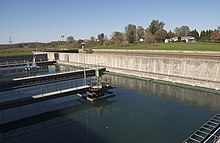Applications
Surface chemistry
In colloid chemistry, flocculation refers to the process by which fine particulates are caused to clump together into a floc. The floc may then float to the top of the liquid (creaming), settle to the bottom of the liquid (sedimentation), or be readily filtered from the liquid. Flocculation behavior of soil colloids is closely related to freshwater quality. High dispersibility of soil colloids not only directly causes turbidity of the surrounding water but it also induces eutrophication due to the adsorption of nutritional substances in rivers and lakes and even boats under the sea.
Physical chemistry
For emulsions, flocculation describes clustering of individual dispersed droplets together, whereby the individual droplets do not lose their identity.[6] Flocculation is thus the initial step leading to further ageing of the emulsion (droplet coalescence and the ultimate separation of the phases). Flocculation is used in mineral dressing,[7] but can be also used in the design of physical properties of food and pharmaceutical products. [8]
Medical diagnostics
In a medical laboratory, flocculation is the core principle used in various diagnostic tests, for example the rapid plasma reagin test.[9]
|
See also: Porges-Meier reaction |
Civil engineering/earth sciences
In civil engineering, and in the earth sciences, flocculation is a condition in which clays, polymers or other small charged particles become attached and form a fragile structure, a floc. In dispersed clay slurries, flocculation occurs after mechanical agitation ceases and the dispersed clay platelets spontaneously form flocs because of attractions between negative face charges and positive edge charges.
Biology
|
See also: Yeast flocculation § Process |
Flocculation is used in biotechnology applications in conjunction with microfiltration to improve the efficiency of biological feeds. The addition of synthetic flocculants to the bioreactor can increase the average particle size making microfiltration more efficient. When flocculants are not added, cakes form and accumulate causing low cell viability. Positively charged flocculants work better than negatively charged ones since the cells are generally negatively charged.[10]
Cheese industry
Flocculation is widely employed to measure the progress of curd formation in the initial stages of cheese making to determine how long the curds must set.[11] The reaction involving the rennet micelles are modeled by Smoluchowski kinetics.[11] During the renneting of milk the micelles can approach one another and flocculate, a process that involves hydrolysis of molecules and macropeptides.[12]
Flocculation is also used during cheese wastewater treatment. Three different coagulants are mainly used:[13]
- FeSO4 (iron(II) sulfate)
- Al2(SO4)3 (aluminium sulfate)
- FeCl3 (iron(III) chloride)
Brewing
|
Main article: Yeast flocculation |
In the brewing industry flocculation has a different meaning. It is a very important process in fermentation during the production of beer where cells form macroscopic flocs. These flocs cause the yeast to sediment or rise to the top of a fermentation at the end of the fermentation. Subsequently, the yeast can be collected (cropped) from the top (ale fermentation) or the bottom (lager fermentation) of the fermenter in order to be reused for the next fermentation.
Yeast flocculation is primarily determined by the calcium concentration, often in the 50-100ppm range.[14] Calcium salts can be added to cause flocculation, or the process can be reversed by removing calcium by adding phosphate to form insolubable calcium phosphate, adding excess sulfate to form insoluble calcium sulfate, or adding EDTA to chelate the calcium ions. While it appears similar to sedimentation in colloidal dispersions, the mechanisms are different.[15]
Water treatment process

Flocculation and sedimentation are widely employed in the purification of drinking water as well as in sewage treatment, storm-water treatment and treatment of industrial wastewater streams. Typical treatment processes consist of grates, coagulation, flocculation, sedimentation, granular filtration and disinfection.[16] As the demand for eco-friendly solutions in the flocculation process continues to grow, biopolymers are emerging as a highly promising solution. Among these, chitosan stands out for its exceptional properties, making it a top contender in this environmentally-conscious endeavor.[17] Chitosan is not only biodegradable but also exhibits a unique ability to bind with a wide range of contaminants, including heavy metals and organic pollutants, effectively removing them from water sources.[18]
